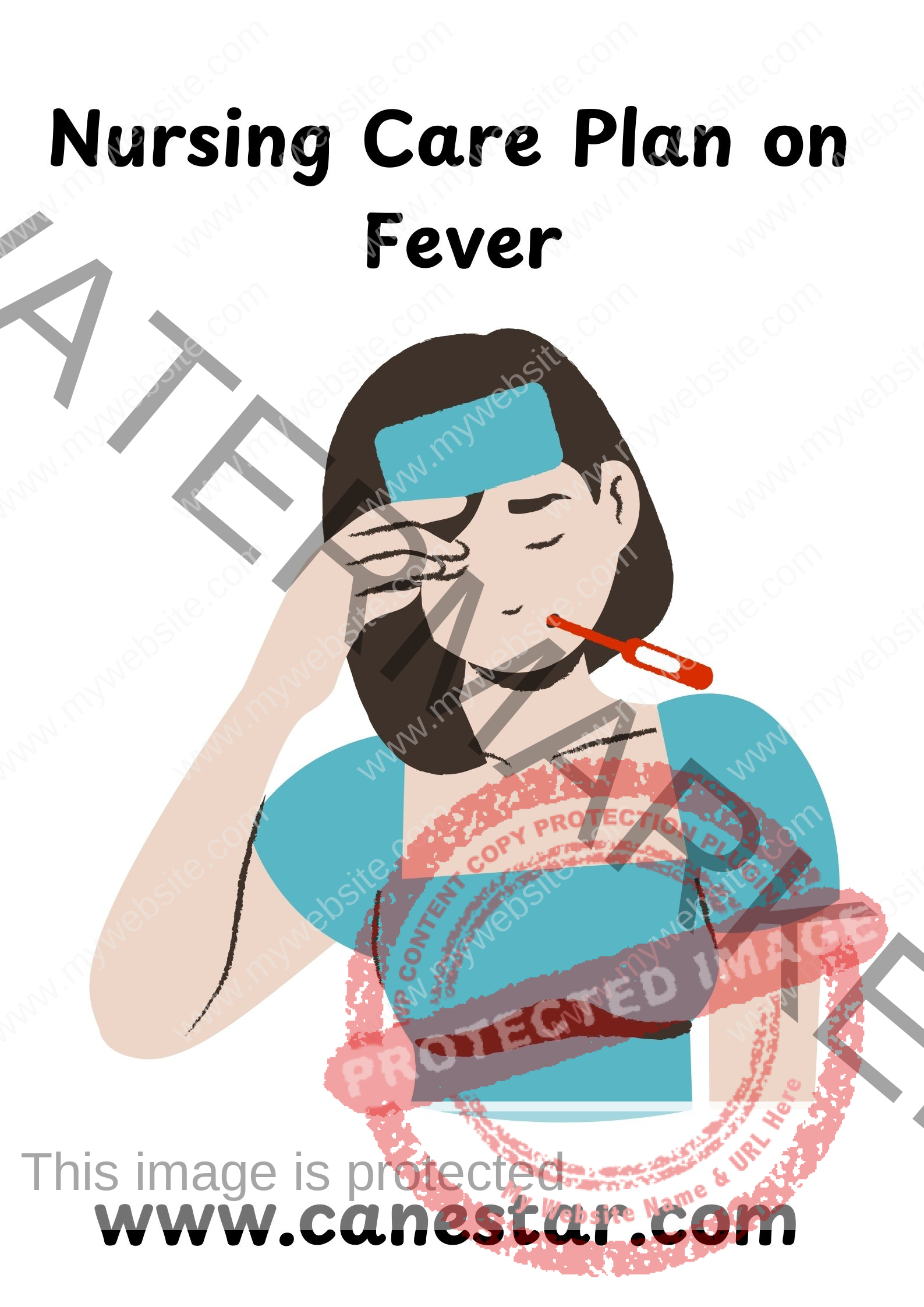NURSING CARE PLAN FOR FEVER
NURSING CARE PLAN ON FEVER
Fever, also known as pyrexia, is a temporary increase in body temperature, often due to an underlying infection or illness. It is the body’s natural defense mechanism to fight off pathogens like viruses and bacteria.
Normal Body Temperature Range:
- Typically ranges from 36.5°C to 37.5°C (97.7°F to 99.5°F).
- Fever is generally defined as a body temperature above 38°C (100.4°F).
Causes of Fever:
Infections:
- Bacterial (e.g., strep throat, pneumonia, urinary tract infections)
- Viral (e.g., influenza, COVID-19, common cold)
- Parasitic (e.g., malaria)
- Fungal (e.g., histoplasmosis)
Inflammatory Conditions:
- Autoimmune diseases (e.g., lupus, rheumatoid arthritis)
Heat Exhaustion:
- Overheating of the body due to prolonged exposure to high temperatures.
Malignancy:
- Certain cancers, such as leukemia or lymphoma, can cause fever.
Medications:
- Some medications can cause drug-induced fever as a side effect.
Vaccines:
- Fever is a common reaction after receiving vaccines, especially in children.
Other Causes:
- Blood clots, trauma, or recent surgery can also cause fever.
Signs and Symptoms:
- Elevated body temperature (above 38°C or 100.4°F)
- Chills or shivering
- Sweating
- Headache
- Muscle aches
- Fatigue and weakness
- Dehydration (dry mouth, reduced urine output)
- Rapid heart rate (tachycardia)
- Loss of appetite
Complications of Prolonged or Severe Fever:
- Dehydration: Loss of fluids through sweating can lead to dehydration.
- Seizures: Febrile seizures, especially in children, can occur with a rapid rise in temperature.
- Delirium: Confusion or delirium can occur in very high fevers.
- Heat stroke: If caused by overheating, fever can progress to heat stroke, a medical emergency.
Nursing Diagnosis: Hyperthermia related to infection, as evidenced by increased body temperature (fever), chills, and fatigue
Subjective Data:
- The patient reports feeling “warm” and “weak.”
- Complaints of body aches and fatigue.
- Mentions experiencing chills and sweating intermittently.
Objective Data:
- Temperature: 38.8°C (101.8°F) (elevated).
- Pulse: 102 beats per minute (tachycardia).
- Skin warm and flushed.
- Patient appears weak and lethargic.
Goal/Outcomes:
- The patient’s body temperature will return to normal levels (below 37.5°C or 99.5°F) within 24–48 hours.
- The patient will report relief from symptoms such as chills and fatigue within 48 hours.
- The patient will demonstrate an understanding of the causes of fever and effective temperature management strategies.
Nursing Interventions & Rationales:
Monitor the patient’s temperature regularly (every 2–4 hours).
- Rationale: Frequent temperature monitoring helps assess the severity of hyperthermia and the effectiveness of interventions.
Administer antipyretics as prescribed (e.g., acetaminophen or ibuprofen).
- Rationale: Antipyretics reduce fever by acting on the hypothalamus to promote heat loss through sweating and vasodilation.
Encourage fluid intake (2-3 liters per day) unless contraindicated.
- Rationale: Fever can lead to dehydration due to increased fluid loss through sweating. Adequate hydration helps maintain circulation and supports the body’s ability to regulate temperature.
Promote rest and energy conservation.
- Rationale: Rest helps conserve energy and allows the immune system to focus on fighting the underlying infection.
Provide cool compresses to the forehead, neck, and armpits, and encourage tepid sponge baths.
- Rationale: These methods help dissipate heat and lower body temperature by promoting evaporative cooling.
Adjust room temperature and provide light blankets as needed.
- Rationale: Maintaining a comfortable environment helps prevent overheating and reduces the workload on the body to maintain temperature homeostasis.
Monitor for signs of dehydration (dry mucous membranes, decreased skin turgor, dark concentrated urine).
- Rationale: Dehydration can occur quickly with fever due to increased fluid loss, and early identification can prevent complications.
Assess for the underlying cause of fever (infection, inflammation, etc.) and report any new symptoms (e.g., rash, cough, vomiting).
- Rationale: Identifying the source of the fever is crucial for determining appropriate treatment, such as antibiotics or other medications.
Teach the patient and family members about infection control practices (e.g., handwashing, avoiding sharing personal items).
- Rationale: Preventing the spread of infection helps reduce reinfection risk and protects others from potential infectious agents.
Encourage a nutritious diet to support the immune system.
- Rationale: Proper nutrition provides the body with the necessary nutrients to fight infection and recover from illness.
Evaluation:
- The patient’s temperature decreased to below 37.5°C (99.5°F) within 24 hours.
- The patient reported reduced symptoms of fatigue and chills.
- The patient demonstrated an understanding of fever management techniques, including fluid intake and temperature monitoring.


